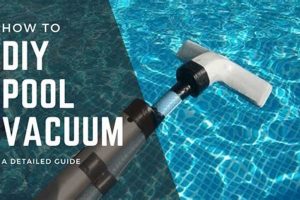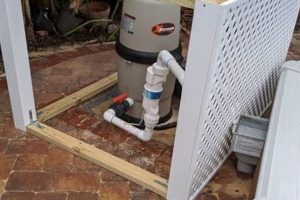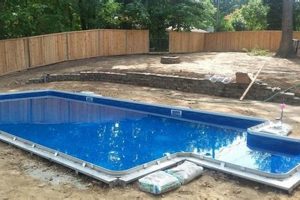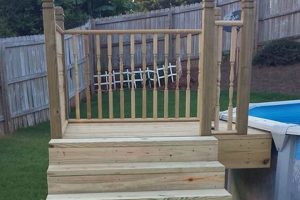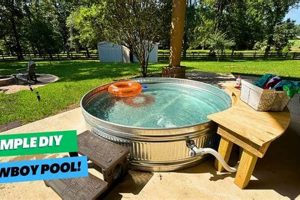A structure designed to enclose a swimming pool, often hemispherical or geodesic in shape, and built by the pool owner rather than a professional installer represents a cost-effective method for extending the swimming season. These structures typically employ materials like PVC pipes, polyethylene sheeting, or polycarbonate panels, assembled to create a protective barrier against the elements. As an example, consider a homeowner constructing a frame from pre-cut PVC pipes connected by fittings, then covering it with UV-resistant plastic to retain heat and block debris.
The implementation of such a protective covering offers numerous advantages. It allows for year-round swimming in climates with colder temperatures, reduces pool maintenance by preventing leaves and other contaminants from entering the water, and can decrease heating costs by trapping solar energy. Historically, simpler versions, like hoop houses adapted for pool coverage, have been utilized to prolong growing seasons for plants; the application of similar principles to swimming pools reflects an adaptation of existing structural techniques. This independent approach is important as it presents an affordable alternative to professionally installed enclosures, expanding access to year-round pool enjoyment.
The following sections will delve into the considerations for material selection, structural design, and construction techniques involved in creating such a feature. It will also address the regulatory aspects and potential challenges associated with this project, along with detailing solutions for maintaining a safe and functional structure.
DIY Swimming Pool Dome
Constructing an enclosure for a swimming pool involves careful planning and execution. These tips offer guidance to ensure structural integrity and longevity.
Tip 1: Accurate Measurement and Planning: Begin with precise measurements of the pool area. Develop a detailed blueprint or 3D model. This will assist in determining material quantities and structural requirements accurately.
Tip 2: Material Selection Considerations: Prioritize UV-resistant materials like polycarbonate or reinforced polyethylene to withstand sun exposure. Consider the local climate and select materials that can endure temperature fluctuations and potential snow loads.
Tip 3: Structural Framework Design: Employ a robust frame design, such as a geodesic or arch structure, to maximize strength and stability. Ensure proper weight distribution to prevent collapse under stress.
Tip 4: Secure Anchoring Systems: Implement a reliable anchoring system to secure the structure to the ground or pool deck. This is critical for preventing displacement during high winds or inclement weather.
Tip 5: Ventilation and Moisture Control: Incorporate ventilation systems to mitigate condensation and prevent mold growth within the enclosure. Proper airflow maintains air quality and prevents material degradation.
Tip 6: Door and Entry Point Design: Design strategically placed and easily accessible doors or entry points. This ensures convenient access for swimming and maintenance.
Tip 7: Regular Inspection and Maintenance: Schedule regular inspections to identify and address any structural weaknesses or damage promptly. Proactive maintenance prolongs the life of the structure.
Adhering to these guidelines contributes significantly to a safe, durable, and functional pool enclosure. Prioritizing planning and structural integrity will help maximize its benefits.
The subsequent sections will delve into potential challenges and solutions, as well as providing a summary of key considerations when approaching this project.
1. Planning
Effective construction of a swimming pool enclosure necessitates detailed planning, forming the foundation for a structurally sound and functionally efficient outcome. Without comprehensive planning, projects risk exceeding budget, failing to meet intended goals, or compromising safety standards.
- Dimensional Assessment and Site Evaluation
This initial phase involves precise measurements of the pool area and a thorough evaluation of the surrounding environment. Accurate dimensions determine the size and shape of the framework and covering, while site evaluation identifies potential challenges like uneven ground, prevailing wind directions, and proximity to trees or other structures. For example, failing to account for a sloping landscape might lead to inadequate anchoring points and structural instability.
- Material Selection and Budget Allocation
Planning requires a rigorous assessment of available materials, considering their durability, UV resistance, and cost-effectiveness. A detailed budget must allocate resources appropriately, factoring in material costs, tool rentals, permit fees, and potential unforeseen expenses. Choosing cheaper, less durable materials may save money initially but could result in frequent repairs or premature failure, ultimately increasing the total cost.
- Structural Design and Engineering Considerations
The design phase entails selecting an appropriate structural framework, such as a geodesic dome or arched structure, based on the pool’s dimensions and local climate conditions. Engineering considerations include calculating load-bearing capacity, wind resistance, and snow load to ensure structural integrity. Neglecting these calculations can result in structural collapse during adverse weather events.
- Permitting and Regulatory Compliance
Planning should include a thorough investigation of local building codes and permit requirements. Compliance with regulations ensures the structure meets safety standards and avoids potential legal issues or fines. Ignoring permit requirements can lead to costly delays, fines, or even the forced removal of the enclosure.
These planning facets are interconnected and crucial to a successful swimming pool enclosure project. Without a robust plan, the project becomes vulnerable to financial overruns, structural instability, and regulatory non-compliance. These factors reinforce planning as an important step towards a durable and valuable addition.
2. Materials
The selection of appropriate materials is foundational to the success of any self-constructed swimming pool enclosure. The correlation between material choice and long-term performance is direct; substandard materials precipitate premature failure, increased maintenance, and diminished cost-effectiveness. For instance, employing non-UV-resistant polyethylene sheeting, though initially economical, will lead to rapid degradation under solar exposure, resulting in brittleness, tearing, and a shortened lifespan. Conversely, investing in durable, UV-stabilized polycarbonate panels, while more expensive upfront, yields greater resistance to weathering, impact, and chemical exposure, thus extending the lifespan of the enclosure. The consequence of improper material selection ranges from aesthetic degradation to structural compromise, potentially endangering users. This understanding is significant because it underscores the necessity for informed decision-making based on the intended use, environmental conditions, and budget constraints.
Practical application of this understanding involves considering specific material properties in relation to design. For a geodesic dome structure, lightweight yet strong materials like aluminum framing combined with polycarbonate panels offer an optimal balance between structural integrity and ease of assembly. In areas prone to heavy snowfall, a steeper roof pitch constructed with high-impact polycarbonate can prevent snow accumulation and reduce the risk of collapse. The anchoring system should be compatible with the foundation material and resistant to corrosion, thereby ensuring the enclosure remains securely fastened during adverse weather conditions. The choice of fasteners, sealants, and adhesives further impacts the structural integrity and water resistance of the entire system.
In summation, the materials employed in a DIY swimming pool enclosure represent a critical determinant of its performance and longevity. The informed selection, guided by environmental factors, structural design, and budget considerations, is paramount to mitigating potential risks and ensuring a safe, durable, and cost-effective swimming pool covering. Challenges arise in balancing initial cost with long-term value, necessitating a comprehensive evaluation of material properties and performance characteristics. This understanding connects directly to the broader theme of responsible construction and the importance of prioritizing quality and durability in self-built structures.
3. Framework
The structural framework is fundamental to the integrity and functionality of any self-constructed swimming pool enclosure. It provides the skeletal support upon which the entire structure relies, dictating its shape, stability, and resistance to environmental stressors. Without a properly designed and executed framework, the enclosure is vulnerable to collapse, deformation, and premature failure.
- Geodesic Dome Frameworks
Geodesic domes offer high strength-to-weight ratios, distributing stress evenly across the structure. This design typically employs interconnected triangles to form a hemispherical or partial-spherical shape. The inherent stability of the geodesic design makes it suitable for regions with high wind or snow loads. For instance, a homeowner might utilize PVC pipes or metal struts connected by specialized hubs to create a geodesic dome framework for their pool covering.
- Arched Frameworks
Arched frameworks use curved structural elements to span the pool area, transferring weight to supporting columns or walls. This design provides a spacious interior and can be adapted to various pool shapes. Arched frameworks are often constructed from wood, steel, or aluminum. A common application involves using laminated wood beams to create an arching structure covered with transparent polycarbonate panels.
- PVC Pipe Frameworks
PVC pipe frameworks are a cost-effective option for smaller swimming pools. PVC pipes are lightweight, easy to cut and assemble, and resistant to corrosion. However, PVC frameworks have lower load-bearing capacity compared to steel or aluminum. These frameworks are frequently used for temporary or seasonal pool enclosures, often covered with polyethylene sheeting.
- Anchoring and Foundation Integration
The framework must be securely anchored to a stable foundation to resist wind uplift and lateral forces. Anchoring methods vary depending on the foundation type, ranging from concrete footings to ground anchors. Proper integration of the framework with the foundation is critical for preventing structural failure. For example, steel frameworks may be bolted to concrete piers, while PVC frameworks may be secured with ground stakes and tension straps.
The choice of framework design and materials should be informed by the pool’s dimensions, local climate conditions, and budget constraints. A robust and well-anchored framework is essential for ensuring the safety, durability, and longevity of any self-constructed swimming pool covering. These structural elements are paramount when approaching this project.
4. Anchoring
Anchoring represents a critical component in the construction of a self-assembled swimming pool covering. Its primary function is to secure the overall structure against external forces, most notably wind uplift. Without a robust anchoring system, the entire structure is vulnerable to displacement, potentially causing damage to the pool, surrounding property, and posing a safety hazard to individuals nearby. The effectiveness of the anchoring directly dictates the lifespan and reliability of the structure. For example, a geodesic dome constructed from PVC pipes and polyethylene sheeting requires substantial anchoring, especially in regions prone to strong winds. Ground stakes, tension straps, and ballast systems are frequently employed to counteract uplift forces. Failure to adequately anchor such a structure can result in it being lifted and carried away by even moderate gusts of wind.
Several factors influence the selection and implementation of an appropriate anchoring method. Soil type plays a key role; loose or sandy soil necessitates deeper or more extensive anchoring systems compared to dense clay or rocky ground. The size and weight of the enclosure also impact the anchoring requirements; larger and heavier structures demand more robust anchoring to resist greater wind loads. Furthermore, the design of the structure itself affects how wind forces are distributed and, consequently, how anchoring should be implemented. Dome-shaped structures, for instance, tend to distribute wind forces more evenly than flat-roofed structures, potentially reducing the overall anchoring requirements. In practice, this means that a carefully planned anchoring system should consider these individual elements to ensure its effectiveness. For instance, a structure built on sandy soil might require helical anchors driven deep into the ground, while a structure on concrete may use expansion bolts to secure the frame.
In summation, anchoring is an indispensable element in the successful construction of a self-assembled swimming pool covering. The careful selection and implementation of an anchoring system appropriate for the specific site conditions, structural design, and expected weather patterns directly correlate to the long-term stability, safety, and overall value of the enclosure. The challenges associated with this aspect are mitigating potential risks associated with the construction. It also links to the broader theme of responsible construction practices.
5. Ventilation
Effective airflow within a self-constructed swimming pool covering is critical for maintaining air quality, preventing moisture buildup, and preserving structural integrity. Insufficient ventilation contributes to a range of problems, including condensation, mold growth, and material degradation, all of which can compromise the longevity and usability of the enclosure.
- Condensation Control
The warm water of a swimming pool generates significant humidity within an enclosed space. Without adequate airflow, this humidity condenses on surfaces, creating a breeding ground for mold and mildew. Effective ventilation removes moisture-laden air and replaces it with drier air, reducing the likelihood of condensation. As an example, strategically placed vents near the roof of the enclosure facilitate the escape of warm, moist air, while lower vents allow cooler, drier air to enter. This natural convection process mitigates condensation buildup. The absence of this exchange system results in water droplets forming on the interior surfaces, encouraging the development of fungi and corroding metal components.
- Air Quality Management
Chemicals used in pool maintenance, such as chlorine, can release volatile organic compounds (VOCs) into the air. Poor ventilation traps these compounds, leading to unpleasant odors and potentially harmful air quality. Cross ventilation, achieved by opening vents or doors on opposite sides of the structure, allows for the continuous circulation of fresh air, diluting and removing VOCs. If ignored, these VOCs accumulate and may cause discomfort to swimmers or accelerate the deterioration of materials within the enclosure.
- Temperature Regulation
Ventilation assists in regulating temperature within the enclosure. During warmer months, allowing air to circulate reduces heat buildup, preventing the interior from becoming uncomfortably hot. Conversely, during colder months, controlled ventilation can help retain heat while still mitigating condensation. Automated vent systems, equipped with temperature sensors, can adjust airflow automatically to maintain a comfortable and consistent environment. The lack of regulated airflow can transform the enclosure into an oven during summer or a damp and chilly space during winter.
- Material Preservation
Excessive moisture and temperature fluctuations, exacerbated by poor ventilation, accelerate the degradation of construction materials. Wood frames can rot, metal components can corrode, and plastic coverings can become brittle. Proper ventilation minimizes these effects, extending the lifespan of the enclosure. Providing a continuous flow of air around structural elements prevents moisture from lingering, thus inhibiting decay and corrosion. A poorly ventilated structure may require frequent repairs or even complete replacement due to material failure.
The integration of appropriate ventilation strategies is thus vital for any self-constructed swimming pool covering, impacting not only the comfort and safety of users but also the long-term durability of the structure. The design should consider natural airflow principles, supplemented by mechanical ventilation systems where necessary, to ensure a healthy and sustainable pool environment. This links directly to construction and the project’s long-term success.
6. Maintenance
The long-term viability of any self-constructed swimming pool enclosure hinges critically on consistent and diligent maintenance. Neglecting necessary upkeep can lead to structural degradation, reduced functionality, and increased costs over time. A proactive maintenance strategy is therefore essential for preserving the investment and ensuring user safety.
- Structural Inspection and Repair
Regular visual inspections of the enclosure’s framework, covering, and anchoring system are paramount. These inspections should identify any signs of damage, such as cracks, tears, corrosion, or loose connections. Prompt repairs of these issues prevent them from escalating into more significant and costly problems. For example, a small tear in the polyethylene covering, left unattended, can quickly expand under wind pressure, necessitating a complete replacement. Similarly, corroded anchoring bolts can compromise the structural stability of the enclosure, increasing the risk of collapse. Scheduled inspections enable early detection and resolution of potential problems, thereby extending the lifespan of the structure.
- Cleaning and Debris Removal
Accumulation of dirt, leaves, and other debris on the enclosure’s surface can reduce light transmission, increase the risk of mold growth, and place additional stress on the structure. Regular cleaning, using appropriate cleaning agents and methods, is necessary to maintain the enclosure’s appearance and functionality. The frequency of cleaning depends on the surrounding environment, with areas prone to high levels of pollen or leaf fall requiring more frequent attention. Failure to remove debris can lead to discoloration of the covering material, reduced solar heat gain, and even structural damage due to the added weight.
- Ventilation System Maintenance
Proper functioning of the ventilation system is essential for controlling humidity, preventing condensation, and maintaining air quality within the enclosure. Regular cleaning of vents and fans ensures optimal airflow. Inspecting for and repairing any blockages or malfunctions of the ventilation system prevents moisture buildup, mold growth, and the accumulation of potentially harmful chemicals. Inadequate ventilation can lead to an unhealthy environment for swimmers and accelerate the deterioration of the enclosure materials.
- Anchoring System Monitoring and Adjustment
The anchoring system is responsible for securing the enclosure against wind uplift and lateral forces. Regular monitoring of the anchoring points ensures they remain securely fastened and properly tensioned. Adjustments may be necessary over time due to soil settlement or changes in weather patterns. Loose or corroded anchors can compromise the structural stability of the enclosure, increasing the risk of damage during high winds. Periodic tightening of anchor bolts and replacement of damaged components is essential for maintaining the integrity of the anchoring system.
The facets of maintenance, when integrated within the operational scope of a swimming pool dome, ensure the sustained performance of the structure while protecting the initial investment. Furthermore, proper maintenance reduces long-term operating costs and enhances the overall pool experience. Therefore, ongoing surveillance, prompt repair, and regular monitoring are fundamental tasks that contribute towards the sustained success of this project.
DIY Swimming Pool Dome
The following addresses common inquiries regarding the planning, construction, and maintenance of a self-assembled swimming pool enclosure. These answers aim to provide clarity and guidance for individuals considering this project.
Question 1: What is the typical lifespan of a self-constructed swimming pool enclosure?
The longevity of such a structure is influenced by material quality, construction methods, and environmental factors. With proper construction and consistent maintenance, a structure can last from 5 to 15 years.
Question 2: Are permits required for a project of this nature?
Local building codes dictate whether a permit is necessary. It is imperative to consult with the local building department to determine specific requirements and ensure compliance with applicable regulations.
Question 3: What structural design offers the most robust protection against heavy snow?
Geodesic dome and steep arch designs generally exhibit superior snow load resistance due to their inherent ability to distribute weight evenly across the structure.
Question 4: How does one mitigate condensation buildup inside the enclosure?
Implementing a well-designed ventilation system, including strategically placed vents and fans, facilitates air circulation and minimizes moisture accumulation.
Question 5: Is it possible to heat a structure of this kind efficiently?
Supplemental heating systems, such as solar water heaters or electric pool heaters, can maintain a comfortable water temperature. Insulation of the enclosure walls can also improve energy efficiency.
Question 6: What is the most effective method for securing the enclosure against strong winds?
Robust anchoring systems, utilizing ground stakes, tension straps, or concrete footings, are essential for preventing displacement during high wind events.
These answers provide a foundation for informed decision-making. However, each project is unique, and further research and consultation with professionals may be necessary.
The following sections offer insights into long-term maintenance and potential challenges that may arise after construction.
DIY Swimming Pool Dome
The foregoing analysis has examined the critical aspects of constructing a self-assembled swimming pool enclosure, emphasizing planning, material selection, structural integrity, ventilation, anchoring, and consistent maintenance. Each element contributes significantly to the project’s overall success, impacting the structure’s longevity, safety, and functionality.
The creation of such a feature represents a significant undertaking, requiring diligent preparation and careful execution. While the prospect of extending the swimming season and reducing pool maintenance costs is attractive, prospective builders must thoroughly assess their skills, resources, and local regulatory requirements before proceeding. This comprehensive evaluation is critical for ensuring a safe, durable, and valuable asset.


